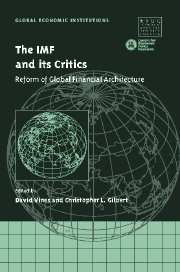Book contents
- Frontmatter
- Contents
- List of figures
- List of tables
- List of contributors
- Acknowledgements
- Introduction
- 1 The IMF and international financial architecture: solvency and liquidity
- 2 Progress towards greater international financial stability
- 3 International coordination of macroeconomic policies: still alive in the new millennium?
- 4 The Report of the International Financial Institution Advisory Commission: comments on the critics
- 5 Reforming the global financial architecture: just tinkering around the edges?
- 6 The IMF and capital account liberalisation
- 7 How should the IMF view capital controls?
- 8 The resolution of international financial crises: an alternative framework
- 9 Whose programme is it? Policy ownership and conditional lending
- 10 The IMF and East Asia: a changing regional financial architecture
- 11 The role of the IMF in developing countries
- 12 Argentina and the Fund: anatomy of a policy failure
- 13 Countries in payments' difficulties: what can the IMF do?
- 14 Accountability, governance and the reform of the IMF
- 15 The IMF at the start of the twenty-first century: what has been learned? On which values can we establish a humanised globalisation?
- Index
- References
2 - Progress towards greater international financial stability
Published online by Cambridge University Press: 04 December 2009
- Frontmatter
- Contents
- List of figures
- List of tables
- List of contributors
- Acknowledgements
- Introduction
- 1 The IMF and international financial architecture: solvency and liquidity
- 2 Progress towards greater international financial stability
- 3 International coordination of macroeconomic policies: still alive in the new millennium?
- 4 The Report of the International Financial Institution Advisory Commission: comments on the critics
- 5 Reforming the global financial architecture: just tinkering around the edges?
- 6 The IMF and capital account liberalisation
- 7 How should the IMF view capital controls?
- 8 The resolution of international financial crises: an alternative framework
- 9 Whose programme is it? Policy ownership and conditional lending
- 10 The IMF and East Asia: a changing regional financial architecture
- 11 The role of the IMF in developing countries
- 12 Argentina and the Fund: anatomy of a policy failure
- 13 Countries in payments' difficulties: what can the IMF do?
- 14 Accountability, governance and the reform of the IMF
- 15 The IMF at the start of the twenty-first century: what has been learned? On which values can we establish a humanised globalisation?
- Index
- References
Summary
Introduction
The decade of the 1990s saw a series of international financial crises on a scale and frequency unprecedented in the post-war period. The economic costs were high, spillover effects were widespread and the political and social consequences were severe. Not surprisingly, calls for the reform of the international financial architecture mounted.
Since 1998 there has been a plethora of international conferences devoted to this general theme. To those who expected them to result in a new ‘system’, comparable in its coherence and comprehensiveness to the Bretton Woods arrangements, the outcome of these deliberations is no doubt a disappointment.
But this would be to set the wrong standard. There is no brand new ‘system’ waiting to be discovered. What has been achieved (inter alia through programmes such as the one sponsored by the ESRC), however, is a better understanding of the strengths and weaknesses of current arrangements. From this flows an agenda of incremental reforms that, if carefully pursued, should result in a stronger and more efficient international monetary system.
There is no realistic alternative to an economic system based on decentralised market forces. This has been virtually universally accepted at the national level since the collapse of centrally planned economic systems in the late 1980s. And it applies equally at the international level. When governments attempt to control decisions about the allocation of real resources, they typically introduce rigidities and inefficiencies that outweigh any benefits stemming from the pursuit of social objectives in economic decisions.
- Type
- Chapter
- Information
- The IMF and its CriticsReform of Global Financial Architecture, pp. 36 - 58Publisher: Cambridge University PressPrint publication year: 2004
References
- 1
- Cited by



